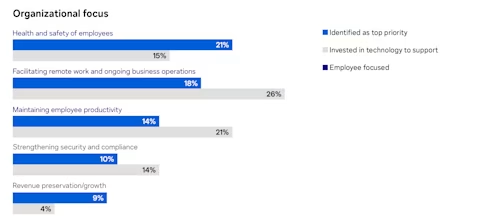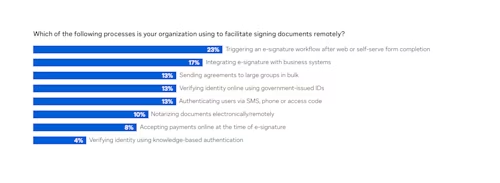
The Current State of Electronic Signature Technology
Learn how modern organizations are using e-signature solutions to get remote work done faster and easier.
- Electronic signature is a global solution to remote work
- Businesses are using e-signature to promote employee safety and productivity
- Not all e-signature solutions are created equal
- Workflows in every department benefit from e-signature
- Stepping beyond e-signature provides a strategic advantage
- Docusign offers a better way to manage agreements
Table of contents
- Electronic signature is a global solution to remote work
- Businesses are using e-signature to promote employee safety and productivity
- Not all e-signature solutions are created equal
- Workflows in every department benefit from e-signature
- Stepping beyond e-signature provides a strategic advantage
- Docusign offers a better way to manage agreements

Shifting consumer expectations, mutable regulatory environments and ongoing technological change drive process transformation in every industry. But, as demonstrated by the events of the past year, the rules can quickly change.
COVID-19 closed offices and disrupted business processes overnight. To facilitate an immediate transition to remote work while retaining operational efficiency, many organizations turned to new, digital solutions. Widespread adoption of electronic signatures led the way, providing corporations around the world with a simple way to streamline a crucial step in the contract management process from home.
Here’s how modern organizations are using e-signature solutions to get remote work done faster and easier.
Electronic signature is a global solution to remote work
It’s impossible to deny COVID-19’s role in moving the digital transformation forward. In an effort to assess the role of the pandemic in accelerating technological change across the globe, Docusign conducted an exhaustive study—surveying and interviewing close to 400 eSignature clients.
As a result of the public health crisis, organizations in every sector say their two biggest current operational challenges are remotely conducting processes that previously required physical signatures and facilitating an effective remote workforce. Additionally, even businesses that used an electronic signature solution before the pandemic reported an increase in the number of documents that need to be signed electronically—often by as much as 100%.
With nearly every organization seeking new ways to improve business continuity over the last year, electronic signature usage has skyrocketed. Ninety percent of Docusign’s eSignature customers, for instance, have significantly increased their usage, with close to half of respondents reporting increases of 50% or more. As the competitive landscape evolves and remote work proliferates, the inefficiencies of manual, paper-based processes become harder to sustain. As a result, the upward trajectory of e-signature adoption is unlikely to slow down in the near future.
Businesses are using e-signature to promote employee safety and productivity
In a strange way, remote work has strengthened relationships between businesses and their employees. During a period of intense social and political unrest, employers recognize that to promote efficiency in the workplace, it’s critical to be attentive and responsive to employee needs. And many are using an electronic signature solution to get there.
The chart below illustrates the results of a poll that surveyed 84 global business leaders’ on their most pressing priorities. The results also highlight how technology is being used to support those concerns.

There is a clear parallel between organizational focus and technological investment. Businesses claim their top priorities are employee safety, business continuity and productivity—and they’re also investing in the technological infrastructure to support those claims. It’s also worth noting that business leaders are now investing in their employees before transactional goals, like revenue or growth.
What does investing in technology to support employee productivity look like in practice? The two tools that respondents were most likely to make an investment in were web conferencing and electronic signature solutions. As organizations adapt to remote work, it’s clear that many professionals are seeking out electronic signature technology as a simple way to support people-centric business concerns—like employee satisfaction and productivity.
Not all e-signature solutions are created equal
Organizations across the globe have identified electronic signature as a viable way to optimize contract workflows and improve employee productivity in a remote work environment. But not all e-signature solutions are created equal. To help business leaders determine what features to look for when implementing e-signature technology, Docusign asked electronic signature users to rank their priorities in selecting a technology solution. In order from highest (1) to lowest (7), their priorities are:
Ease of use
Speed of implementation
Security and compliance
Assistance in implementation
Cost
Risk mitigation
Scalability
Maximum efficiency is best achieved through the careful implementation of the right technology in the right place at the right time. Before landing on an e-signature solution, make sure it’s one that will best meet organizational needs now and into the future.
Workflows in every department benefit from e-signature
What does an e-signature solution look like in action? To help establish a better understanding of how organizations are benefiting from e-signature implementation, Docusign spoke with eSignature customers from around the globe. Here’s how e-signature technology and other integrated tools have helped corporations across a wide range of industries meet the challenges of the new business landscape.
Modernized remote employee communication: Around the world, HR teams find themselves fielding a flurry of policy updates focused on safely and efficiently transitioning teams to remote work. Thanks to bulk send-and-sign capabilities, information can be easily shared at an enterprise level. For documents that contain sensitive information, HR teams can even utilize ID verification tools to maintain secure data sharing in a remote environment—confirming employee identity upon receipt.
Faster government loan processing: Financial institutions have an important role to play in the battle to keep small businesses open. Processing COVID-relief requests and loans efficiently helps these institutions serve more customers—which means millions of business owners get to keep their lights on.
Empowering citizens with self-service tools: At the center of the pandemic, the healthcare industry has provided lifesaving care to patients across the globe—while dealing with greater patient volumes and public safety concerns than ever before.
How? With the help of features like PowerForms and GuidedForms, public health organizations at the state, county and city level have provided patients with efficient, remote solutions to onboarding and intake processes. Less time spent on paperwork means more people (safely) get the care they need.
Stepping beyond e-signature provides a strategic advantage
Overall, the tactical implementation of an e-signature solution has led to tangible advantages for organizations in every sector. Expanding that agreement system beyond simply collecting a signature creates even more opportunities for business efficiency and growth. For instance, Docusign customers report using additional digital processes to facilitate more efficient remote agreement practices, including:

Automation may start with the tactical implementation of an electronic signature. But end-to-end automation at every stage of the contract management process helps create a document management strategy with advantages that extend far beyond COVID response, such as:
greater business agility
reduced risk
lower costs
better visibility
increased productivity
higher employee/customer satisfaction
Docusign offers a better way to manage agreements
Every part of business relies on the ability to efficiently generate, sign and act on agreements. In today’s fast-moving, remote marketplace, the Docusign Agreement Cloud provides organizations around the world with a simple, secure way to manage agreements. Send, sign and watch business soar with the world’s #1 electronic signature solution.
Related posts
Docusign IAM is the agreement platform your business needs



